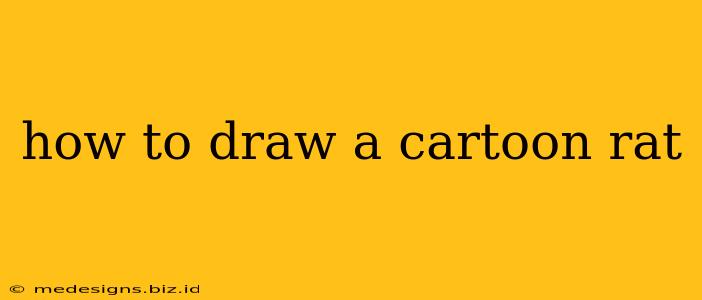Drawing a cartoon rat might seem daunting, but with a few simple steps, you can create a charming, funny, or even mischievous rodent character. This guide will walk you through the process, from basic shapes to adding personality. Whether you're a beginner or looking to refine your skills, let's dive in!
Getting Started: Materials and Basic Shapes
Before we begin sketching our cartoon rat, gather your materials. You'll need:
- Paper: Any drawing paper will do, but thicker paper is preferable to prevent smudging.
- Pencil: A standard HB pencil is ideal for sketching. A softer pencil (like a 2B) can be used for shading later.
- Eraser: A good eraser is essential for correcting mistakes.
- Optional: Colored pencils, markers, or paints for adding color and detail.
We'll start with basic shapes to build our rat's body. Think of simple forms like circles, ovals, and triangles. Don't worry about perfection at this stage; this is just a foundation.
Step 1: The Body
Begin by drawing an oval for the rat's body. This oval doesn't need to be perfect; a slightly irregular shape will add character.
Step 2: The Head
Next, add a slightly smaller circle overlapping the top of the oval. This will be the head. The overlap creates a smooth transition between the body and head.
Refining the Shape: Adding Details to Your Cartoon Rat
Now that we have the basic structure, let's add some defining features:
Step 3: The Ears
Rats have distinctive ears. Draw two rounded triangles on top of the head. Experiment with the size and shape of the ears to create different expressions. Large ears might make your rat look more playful, while smaller ears could give it a more serious look.
Step 4: The Face
Let's bring your cartoon rat to life with its facial features. Use simple shapes again:
- Eyes: Two small circles or ovals. The positioning and size of the eyes can dramatically change the expression. Close-set eyes might convey cunning, while wide-set eyes suggest innocence or surprise.
- Nose: A small triangle or heart shape works well for a cartoon rat's nose.
- Mouth: A simple curved line can represent a smile, frown, or even an open mouth.
Step 5: The Tail
Rats have long, slender tails. Draw a long, curving line extending from the back of the body. The tail can be straight, curved, or even knotted for a more playful effect.
Step 6: The Legs and Feet
Add four small, stubby legs underneath the body. Keep them simple—a few short lines for the legs and small circles or ovals for the feet.
Adding Personality and Finishing Touches
Your cartoon rat is taking shape! Now it's time to add personality and refine the details:
Step 7: Fur and Texture
You can add texture to your cartoon rat by drawing light, short lines all over its body to simulate fur. Focus on the direction of the strokes to create a sense of movement and depth.
Step 8: Shading
Add depth and dimension by lightly shading areas where shadows would naturally fall. This will make your rat look more realistic and three-dimensional.
Step 9: Adding Color (Optional)
If you're using color, choose shades that complement each other. A grey or brown base with accents of other colors can create a vibrant and appealing cartoon rat.
Different Cartoon Rat Styles
Experiment with different styles to find what you like best. You can create a cute rat, a mischievous rat, or even a scary rat, simply by adjusting the proportions and features. Consider these variations:
- Rounder Shapes: For a cuter look.
- Sharper Lines: For a more aggressive or mischievous look.
- Exaggerated Features: Large eyes, a tiny nose, or a huge tail can add humor and personality.
Remember, practice is key! The more you draw, the better you'll become at creating unique and expressive cartoon rats. Don't be afraid to experiment and have fun with it!
